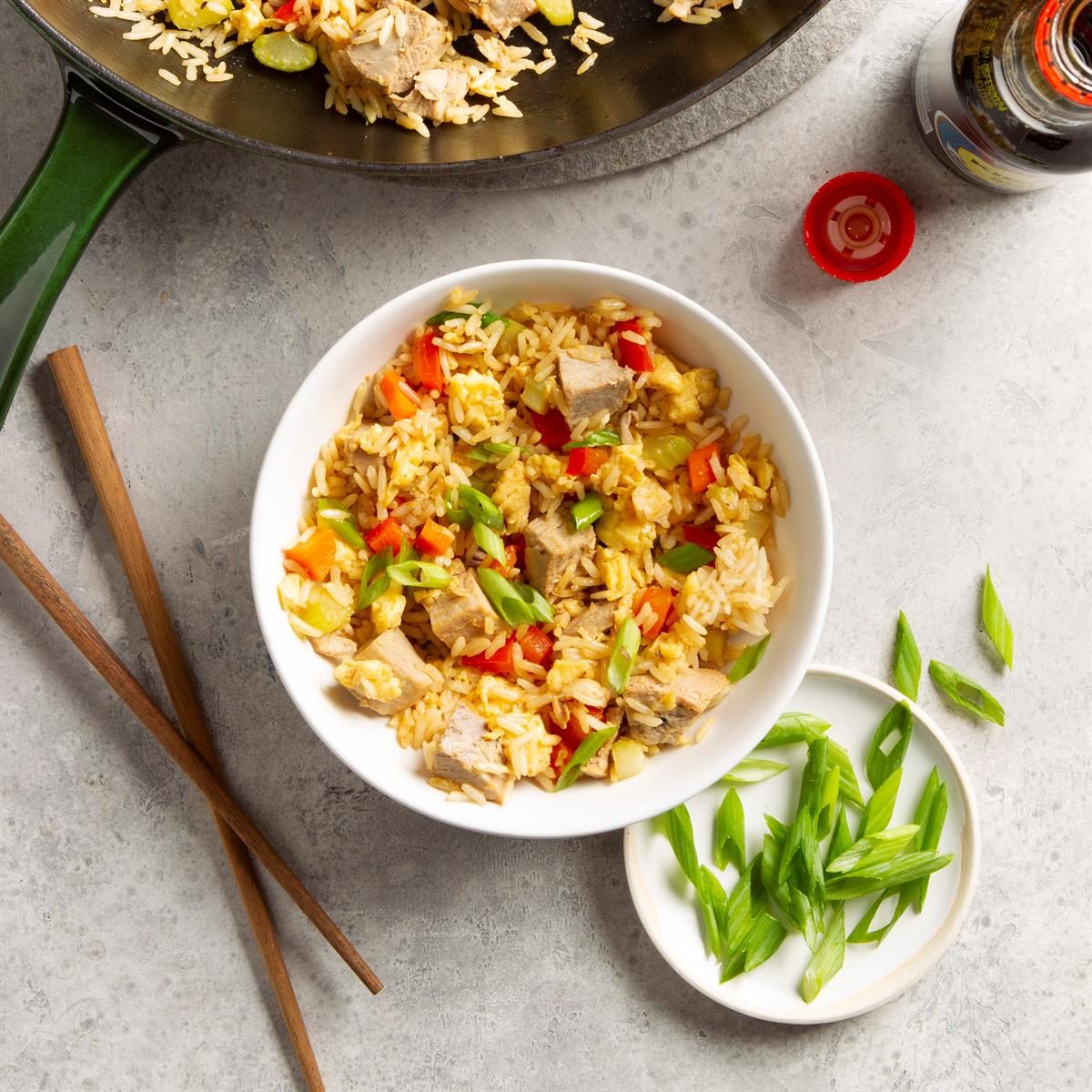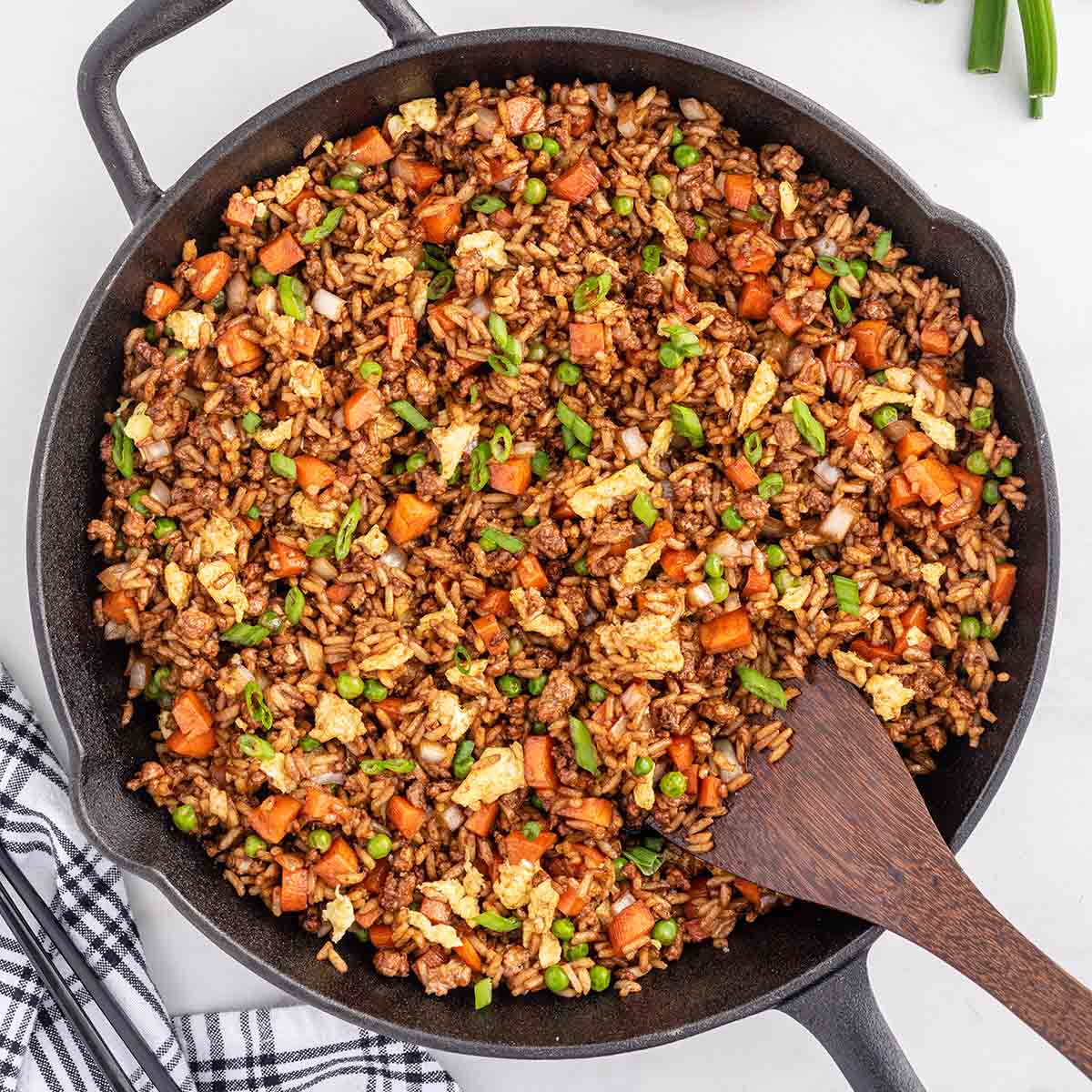Video tentang Pork Fried Rice: A Culinary Journey Through Time and Taste
Pork Fried Rice: A Culinary Journey Through Time and Taste

Pork fried rice. The name itself conjures images of sizzling woks, fragrant steam, and a symphony of savory flavors. This seemingly simple dish, a cornerstone of countless cuisines across the globe, is far more than just leftover rice repurposed. It’s a testament to culinary ingenuity, a canvas for creativity, and a delicious journey through time and diverse culinary traditions. From humble beginnings in China to its ubiquitous presence on menus worldwide, pork fried rice holds a special place in our collective culinary consciousness.
A History Steeped in Rice:
The origins of fried rice are deeply rooted in Chinese cuisine, specifically emerging from the resourceful practices of its cooks. Long before refrigeration was commonplace, resourceful chefs found ways to utilize leftover cooked rice, transforming it into a delectable new dish. The process of frying the rice, initially a way to prevent spoilage, unexpectedly elevated the humble grain to new heights of flavor and texture. The precise date of its invention remains shrouded in the mists of history, but its evolution is well-documented through culinary chronicles and the evolving tastes of generations.
Early forms of fried rice likely involved simple ingredients: rice, soy sauce, and perhaps some vegetables. The addition of protein, such as pork, came later, likely reflecting the increasing availability and affordability of pork in various regions. This addition significantly enhanced the dish’s nutritional value and flavor profile, leading to the popular pork fried rice we know and love today.
The dish’s popularity spread rapidly, migrating along trade routes and through cultural exchange. It found its way into other Asian cuisines, adapting and evolving to incorporate local ingredients and flavors. From the vibrant street food stalls of Southeast Asia to the refined kitchens of high-end restaurants, pork fried rice has proven its adaptability and enduring appeal.
The Magic of the Wok:
The wok, a quintessential piece of Asian cookware, plays a crucial role in the creation of exceptional pork fried rice. Its curved shape and sloped sides allow for even heat distribution and rapid cooking, crucial for achieving the characteristically light and fluffy texture of the rice grains. The high heat of the wok also helps to create a delightful "wok hei," a smoky, slightly charred flavor that adds depth and complexity to the dish. This unique flavor is difficult to replicate using other cooking methods, highlighting the importance of the wok in the pork fried rice experience.
The skill of the cook is also paramount. The rapid tossing and stirring of the ingredients in the wok requires precision and timing, ensuring that the rice is cooked evenly without becoming mushy, and that the other ingredients are cooked to perfection. This skillful manipulation of the ingredients, along with the right heat control, is what separates truly great pork fried rice from the mediocre.
A Symphony of Flavors and Textures:
The beauty of pork fried rice lies in its versatility. While the basic ingredients remain consistent – rice, pork, and soy sauce – the possibilities for customization are endless. Different cuts of pork can be used, each imparting its unique flavor and texture. Tenderloin provides a lean and delicate taste, while belly offers a richer, more flavorful experience. Ground pork adds a different dimension, its fine texture blending seamlessly with the rice.

The addition of vegetables further enhances the dish’s nutritional value and flavor complexity. Common additions include peas, carrots, onions, and scallions, their vibrant colors and fresh flavors complementing the savory pork and rice. More adventurous cooks might incorporate other vegetables like mushrooms, bell peppers, or even bok choy, adding layers of texture and taste.
The sauce is another crucial element. While soy sauce forms the foundation, other ingredients can be added to create a unique flavor profile. A touch of oyster sauce adds a savory umami depth, while a dash of sesame oil provides a nutty aroma. Ginger and garlic are frequently used to add a pungent kick, while a sprinkle of white pepper adds a subtle warmth. The balance of these ingredients is key to achieving the perfect flavor harmony.
Variations on a Theme:
The global popularity of pork fried rice has led to countless regional variations. In some parts of China, char siu (barbecued pork) is used, adding a sweet and smoky dimension to the dish. In other regions, shrimp or chicken might replace the pork, creating equally delicious variations. Some versions incorporate eggs, adding richness and a creamy texture. The addition of fermented black beans or chili garlic sauce introduces a spicy element, appealing to those who prefer a bolder flavor profile.
The use of different types of rice also impacts the final product. Long-grain rice tends to produce a more distinct, separate texture, while short-grain rice results in a softer, more cohesive dish. The choice of rice is often dictated by regional preferences and culinary traditions.

Beyond the Plate: Pork Fried Rice in Culture and Cuisine:
Pork fried rice transcends its status as a simple dish. It’s a staple in countless households, a comforting meal enjoyed by families across generations. It’s a ubiquitous presence on restaurant menus, a reliable choice for a quick and satisfying meal. It’s also a versatile ingredient in other dishes, sometimes incorporated into spring rolls or used as a filling for dumplings.
Its cultural significance is evident in its presence in popular culture, often appearing in movies, television shows, and books as a symbol of comfort, familiarity, and home-cooked goodness. Its adaptability and enduring popularity make it a true culinary chameleon, capable of satisfying diverse palates and culinary preferences.
A Recipe for Success:
While numerous variations exist, a basic recipe for pork fried rice provides a solid foundation for culinary experimentation. Here’s a simple recipe to get you started:
:max_bytes(150000):strip_icc()/8535348_Leftover-Pork-Fried-Rice_thedailygourmet_4x3-d5a1926b8a5641868dd48949f09d6463.jpg)
Ingredients:
- 2 cups cooked day-old rice
- 1 cup diced pork
- 1/2 cup diced onion
- 1/2 cup diced carrots
- 1/4 cup frozen peas
- 2 tablespoons soy sauce
- 1 tablespoon oyster sauce
- 1 teaspoon sesame oil
- 1 clove garlic, minced
- 2 scallions, chopped
- Vegetable oil for cooking
Instructions:
- Heat vegetable oil in a wok or large skillet over medium-high heat.
- Add pork and cook until browned.
- Add onion and carrots and cook until softened.
- Add garlic and cook for 30 seconds until fragrant.
- Add rice and stir-fry until heated through.
- Add soy sauce, oyster sauce, and sesame oil. Stir to combine.
- Add peas and scallions. Stir-fry until heated through.
- Serve hot.
This is merely a starting point. Feel free to experiment with different ingredients and seasonings to create your own signature pork fried rice masterpiece. The possibilities are as limitless as your culinary imagination.
In conclusion, pork fried rice is more than just a dish; it’s a culinary journey, a testament to human ingenuity, and a delicious expression of cultural exchange. Its enduring popularity and adaptability ensure that this seemingly simple dish will continue to delight palates and inspire cooks for generations to come. So, grab your wok, gather your ingredients, and embark on your own culinary adventure with this timeless classic.

Penutup
Therefore, we hope this article has provided valuable insights on Pork Fried Rice: A Culinary Journey Through Time and Taste. We hope you found this article informative and helpful. See you in our next article!

